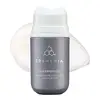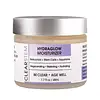What's inside
What's inside
 Key Ingredients
Key Ingredients

 Benefits
Benefits

 Concerns
Concerns

No concerns
 Ingredients Side-by-side
Ingredients Side-by-side

Water
Skin ConditioningCaprylic/Capric Triglyceride
MaskingGlycerin
HumectantPentylene Glycol
Skin ConditioningGlyceryl Stearate
EmollientLactobacillus Ferment Lysate Filtrate
Skin ConditioningHydrogenated Ethylhexyl Olivate
EmollientSqualane
EmollientMangifera Indica Seed Butter
Skin ConditioningVitis Vinifera Fruit Extract
Skin ConditioningZingiber Officinale Root Extract
MaskingBoswellia Serrata Extract
Skin ConditioningChlorella Vulgaris Extract
Skin ConditioningRhodiola Rosea Root Extract
EmollientInonotus Obliquus Extract
Skin ConditioningGanoderma Lucidum Extract
Skin ProtectingWithania Somnifera Root Extract
Skin ConditioningLeuconostoc/Radish Root Ferment Filtrate
AntimicrobialPopulus Tremuloides Bark Extract
AntiseborrhoeicTremella Fuciformis Sporocarp Extract
AntioxidantPanthenol
Skin ConditioningBisabolol
MaskingCetearyl Alcohol
EmollientXanthan Gum
EmulsifyingHydroxyacetophenone
AntioxidantAmmonium Acryloyldimethyltaurate/Vp Copolymer
Sodium Stearoyl Lactylate
Emulsifying1,2-Hexanediol
Skin ConditioningCaprylyl Glycol
EmollientSodium Hydroxide
BufferingHydrogenated Olive Oil Unsaponifiables
EmollientPropanediol
SolventLavandula Angustifolia Flower/Leaf/Stem Extract
MaskingSodium Phytate
Citric Acid
BufferingLactic Acid
BufferingSodium Benzoate
MaskingWater, Caprylic/Capric Triglyceride, Glycerin, Pentylene Glycol, Glyceryl Stearate, Lactobacillus Ferment Lysate Filtrate, Hydrogenated Ethylhexyl Olivate, Squalane, Mangifera Indica Seed Butter, Vitis Vinifera Fruit Extract, Zingiber Officinale Root Extract, Boswellia Serrata Extract, Chlorella Vulgaris Extract, Rhodiola Rosea Root Extract, Inonotus Obliquus Extract, Ganoderma Lucidum Extract, Withania Somnifera Root Extract, Leuconostoc/Radish Root Ferment Filtrate, Populus Tremuloides Bark Extract, Tremella Fuciformis Sporocarp Extract, Panthenol, Bisabolol, Cetearyl Alcohol, Xanthan Gum, Hydroxyacetophenone, Ammonium Acryloyldimethyltaurate/Vp Copolymer, Sodium Stearoyl Lactylate, 1,2-Hexanediol, Caprylyl Glycol, Sodium Hydroxide, Hydrogenated Olive Oil Unsaponifiables, Propanediol, Lavandula Angustifolia Flower/Leaf/Stem Extract, Sodium Phytate, Citric Acid, Lactic Acid, Sodium Benzoate
Water
Skin ConditioningSqualane
EmollientPropanediol
SolventCannabis Sativa Seed Oil
EmollientPunica Granatum Seed Oil
EmollientPolyglyceryl-6 Distearate
EmulsifyingGlycerin
HumectantCetyl Alcohol
EmollientRaphanus Sativus Seed Extract
Skin ConditioningBakuchiol
AntimicrobialAloe Barbadensis Leaf Extract
EmollientHyaluronic Acid
HumectantJojoba Esters
EmollientOlibanum
MaskingCamellia Sinensis Extract
AntioxidantSodium Cocoyl/Stearoyl (Alanine/Arginine/Asparagine/Aspartic Acid/Glutamic Acid/Glutamine/Glycine/Histidine/Isoleucine/Leucine/Lysine/Phenylalanine/Proline/Serine/Threonine/Tyrosine/Valine)
EmollientPhenylalanine
MaskingArgania Spinosa Sprout Cell Extract
Skin ConditioningCurcuma Longa Root Extract
MaskingTanacetum Annuum Flower Oil
MaskingLactobacillus Ferment
Skin ConditioningDiglucosyl Gallic Acid
Thioctic Acid
AntioxidantLactic Acid
BufferingXanthan Gum
EmulsifyingCaprylyl Glycol
EmollientEthylhexylglycerin
Skin ConditioningWater, Squalane, Propanediol, Cannabis Sativa Seed Oil, Punica Granatum Seed Oil, Polyglyceryl-6 Distearate, Glycerin, Cetyl Alcohol, Raphanus Sativus Seed Extract, Bakuchiol, Aloe Barbadensis Leaf Extract, Hyaluronic Acid, Jojoba Esters, Olibanum, Camellia Sinensis Extract, Sodium Cocoyl/Stearoyl (Alanine/Arginine/Asparagine/Aspartic Acid/Glutamic Acid/Glutamine/Glycine/Histidine/Isoleucine/Leucine/Lysine/Phenylalanine/Proline/Serine/Threonine/Tyrosine/Valine), Phenylalanine, Argania Spinosa Sprout Cell Extract, Curcuma Longa Root Extract, Tanacetum Annuum Flower Oil, Lactobacillus Ferment, Diglucosyl Gallic Acid, Thioctic Acid, Lactic Acid, Xanthan Gum, Caprylyl Glycol, Ethylhexylglycerin
 Reviews
Reviews

Ingredients Explained
These ingredients are found in both products.
Ingredients higher up in an ingredient list are typically present in a larger amount.
Caprylyl Glycol is a humectant and emollient, meaning it attracts and preserves moisture.
It is a common ingredient in many products, especially those designed to hydrate skin. The primary benefits are retaining moisture, skin softening, and promoting a healthy skin barrier.
Though Caprylyl Glycol is an alcohol derived from fatty acids, it is not the kind that can dry out skin.
This ingredient is also used as a preservative to extend the life of products. It has slight antimicrobial properties.
Learn more about Caprylyl GlycolGlycerin is already naturally found in your skin. It helps moisturize and protect your skin.
A study from 2016 found glycerin to be more effective as a humectant than AHAs and hyaluronic acid.
As a humectant, it helps the skin stay hydrated by pulling moisture to your skin. The low molecular weight of glycerin allows it to pull moisture into the deeper layers of your skin.
Hydrated skin improves your skin barrier; Your skin barrier helps protect against irritants and bacteria.
Glycerin has also been found to have antimicrobial and antiviral properties. Due to these properties, glycerin is often used in wound and burn treatments.
In cosmetics, glycerin is usually derived from plants such as soybean or palm. However, it can also be sourced from animals, such as tallow or animal fat.
This ingredient is organic, colorless, odorless, and non-toxic.
Glycerin is the name for this ingredient in American English. British English uses Glycerol/Glycerine.
Learn more about GlycerinLactic Acid is another well-loved alpha hydroxy acid (AHA). It is gentler than glycolic acid but still highly effective.
Its main role is to exfoliate the surface of the skin by loosening the “glue” that holds dead skin cells together. Shedding those old cells leads to smoother, softer, and more even-toned skin.
Because lactic acid molecules are larger than glycolic acid, they don’t penetrate as deeply. This means they’re less likely to sting or irritate, making it a great choice for beginners or those with sensitive skin.
Like glycolic acid, it can:
Lactic acid also acts as a humectant (like hyaluronic acid). It can draw water into the skin to improve hydration and also plays a role in the skin's natural moisturizing factor (NMF) in the form of sodium lactate.
Studies show it can boost ceramide production to strengthen the skin barrier and even help balance the skin’s microbiome.
To get results, choose products with a pH between 3-4.
Lower strengths (5-12%) focus on surface exfoliation; higher strengths (12% and up) can reach deeper in the dermis (deeper, supportive layer) to improve skin texture and firmness over time.
Though it was originally derived from milk, most modern lactic acid used in skincare is vegan. It is made through non-dairy fermentation to create a bio-identical and stable form suitable for all formulations.
When lactic acid shows up near the end of an ingredient list, it usually means the brand added just a tiny amount to adjust the product’s pH.
Legend has it that Cleopatra used to bathe in sour milk to help reduce wrinkles.
Lactic acid is truly a gentle multitasker: it exfoliates, hydrates, strengthens, and brightens. It's a great ingredient for giving your skin a smooth, glowing, and healthy look without the harshness of stronger acids.
Read more about some other popular AHA's here:
Learn more about Lactic AcidPropanediol is an all-star ingredient. It softens, hydrates, and smooths the skin.
It’s often used to:
Propanediol is not likely to cause sensitivity and considered safe to use. It is derived from corn or petroleum with a clear color and no scent.
Learn more about PropanediolSqualane is an emollient that helps the skin hold onto moisture. It's an oily liquid that occurs naturally in certain types of fish and plant oils.
Because squalane boosts hydration in the skin, it also comes with plenty of benefits: it is an antioxidant and can help fight free radicals and skin damage. Squalane is also found to have a detoxifying effect when applied.
Squalane comes from squalene, which occurs naturally within the sebum of our skin. It is one of the oils our skin produces to keep itself hydrated. Squalane is the hydrogenated version of squalene and has a longer shelf life.
Research shows that squalane is non-irritating (even at 100% concentration).
In general, it's a fantastic ingredient. It does a great job at hydrating the skin, and it's suitable for those with sensitive skin.
The source of squalane may impact malassezia / fungal acne. This is because olive oil derived squalane can contain impurities such as fatty acids and plant waxes. Sugarcane derived squalane is recommended for anyone with malassezia concerns.
Is squalane vegan?
This depends on the source. Squalane can be derived from both plants and animals. Most squalane used in skincare comes from plants.
Please note: the source of squalane is only known if disclosed by the brand. We recommend reaching out to the brand if you have any questions about their squalane.
Read more about squalene with an "e".
Is squalane an oil?
Squalane is often called an oil, but it’s technically not; it’s a hydrocarbon, meaning it’s only made of carbon and hydrogen, unlike true oils which are triglycerides made of fatty acids and glycerol.
The term “oil-free” isn’t regulated, so companies can define it however they want. Some exclude all oils, while others just avoid mineral oil or comedogenic oils.
While some people avoid oils thinking they cause breakouts, the right kind of oil (or oil-like ingredient like squalane) can actually help balance and hydrate your skin. It’s worth testing out simple oils or squalane to see what works best for your skin.
Learn more about SqualaneWater. It's the most common cosmetic ingredient of all. You'll usually see it at the top of ingredient lists, meaning that it makes up the largest part of the product.
So why is it so popular? Water most often acts as a solvent - this means that it helps dissolve other ingredients into the formulation.
You'll also recognize water as that liquid we all need to stay alive. If you see this, drink a glass of water. Stay hydrated!
Learn more about WaterXanthan gum is used as a stabilizer and thickener within cosmetic products. It helps give products a sticky, thick feeling - preventing them from being too runny.
On the technical side of things, xanthan gum is a polysaccharide - a combination consisting of multiple sugar molecules bonded together.
Xanthan gum is a pretty common and great ingredient. It is a natural, non-toxic, non-irritating ingredient that is also commonly used in food products.
Learn more about Xanthan Gum